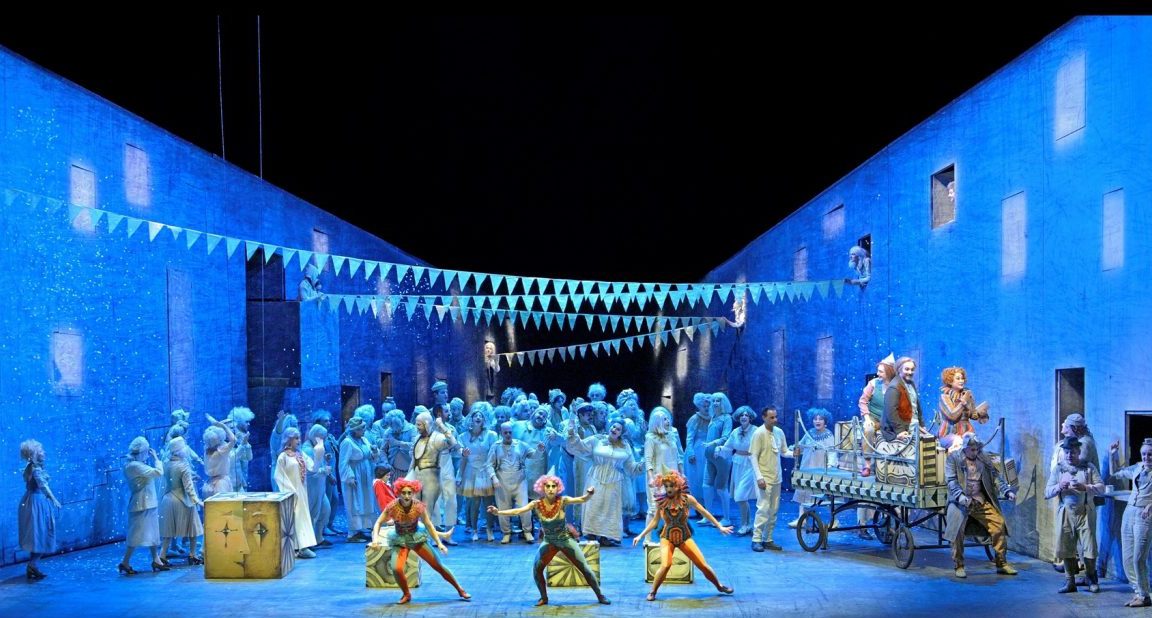Before it all started, the big screen in front of the stage turned blue and yellow. With it a message appeared: “The opera embraces the people of Ukraine in these difficult days”. This apt gesture drew cheers from the crowd, especially as Kalmuchyn Dmytro – the baritone singing the role of Silvio in other nights – is Ukrainian. His family back home is now dealing with the Russian invasion.
Three years ago, Inbal Pinto, an Israeli choreographer, director and set and costume designer, was approached by the Israeli opera with an offer to direct an opera of her choosing. She chose Ruggero Leoncavallo’s comic tragedy Pagliacci. At the time, the Israeli Opera intended to pair it with Schitz, an original Israeli opera, instead of the usual Cavalleria Rusticana. But then Covid-19 hit, and the plans where put on hold.
Now Pinto’s Pagliacci has finally opened on its own, and the production is so rich, lively and engaging that the audience does not feel short changed when the performance ends after 75 minutes.
Pinto comes from the world of dance, and she brought with her a fresh attitude to the operatic stage. This new production is completely her vision, as she did everything except singing. Pinto designed the sets and the costumes (including the animated images of clowns projected on a small screen in the prologue), created the choreography for the numerous dancers, and also taught the singers how to move – much more than they are used to.
Leoncavallo’s verismo melodrama from 1892 takes place in a small Italian town where a troupe of travelling actors has arrived. Canio, head of the troupe, sings about the difference between life and theater, by which he means Commedia dell’arte. Later he will find that life reflects the theater – as his wife Nedda has an affair with a local guy named Silvio, just like the character Colombina which she plays on stage. Driven by rage he will murder both his wife and lover on stage during the play. In our times, the famous ending, in which he yells “La commedia è finita!!” sounds hollow, as the tragedy is no more that of the murderous clown but that of his wife and victim.
In Pinto’s production, two walls with numerous windows and doors on both side of the stage represent the town. The town’s residents are very much a part of the drama, as they closely witness Canio’s growing jealousy, on and off stage – their constant presence adds to his agony. When Nedda sings about wanting to free herself from her marriage and fly like bird, dancers in white simulate a flock of birds behind her in one of the highlights of the performance. Another truly memorable sight is that of the play in the second act, in which three pantomimes shadow Colombina as she waits for her lover. Early in the evening there are four clowns dressed in gorgeous colors, but the costumes of the lead characters are in faded hues, adding a touch of realism to the low-rent troupe.
Musically this production is also quite a treat. Under the guidance of conductor Daniele Callegari the orchestra sounded dynamic and bigger than it actually is. Romanian Baritone Ionut Pascu was outstanding as the hunchback fool Tonio who lusts after Nedda, his gorgeous voice piercing the air. Nedda herself was beautifully sung and performed by soprano Elisa Cho from South Korea, who managed to move like a dancer. The performance’s Achilles heel was Julien van Mellaerts, who had trouble reaching the high notes in the role of the lover Silvio. Much better was Eitan Drori from Israel, whose lyrical tenor voice sounded truly beautiful in the small role of Beppe. Samuele Simoncini cast in the lead role of the jealous clown has a raspy tenor which is an acquired taste, but when he sang his famous aria Vesti la giubba he gave it all, and captivated the audience.

